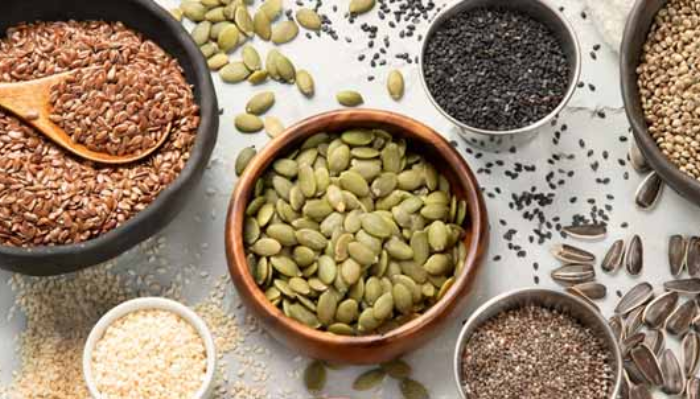
Seeds have taken center stage in the world of superfoods—and for good reason. These tiny nutritional powerhouses like chia, flax, sunflower, pumpkin, sesame, and hemp are brimming with fiber, healthy fats, protein, and essential minerals. You’ll find them tossed into smoothies, sprinkled over salads, stirred into yogurts, and even baked into breads.
But how you eat these seeds matters just as much as the seeds themselves. While raw might sound healthiest, ancient cultures knew better. From Ayurveda to Aztec traditions, seeds were rarely eaten raw. They were soaked, roasted, ground, or even turned into pastes—each method tailored to make them more digestible, safer, and energetically balanced.
Let’s dive into the how and why—with Ayurvedic wisdom and modern science guiding the way.
In India and the Middle East, sabja seeds (also known as Tukmaria or sweet basil seeds) are a cooling summer staple. You’ll find them in falooda, a sweet milk-based drink. Similarly, in Mexico, chia seeds were soaked in lime water to make chia fresca.
Soaking not only improves texture—it prevents choking, especially since these seeds can swell up to 27 times their dry size. Soaking also helps reduce phytic acid, which can block mineral absorption, and makes the fiber easier to digest.
Raw flaxseeds contain cyanogenic compounds that can be problematic in large quantities. They also have a hard outer shell that the body can’t break down easily. Roasting or grinding them enhances digestibility and nutrient absorption, especially for omega-3s and lignans.
Sesame seeds, though nutrient-dense, are also heating, oily, and dense. In traditional Indian cuisine, they’re often paired with jaggery to make ladoos or ground into tahini in Middle Eastern cuisine. This reduces the risk of overheating and balances the seed’s natural intensity.
Raw pumpkin and sunflower seeds contain phytates that hinder mineral absorption and can irritate the gut. Plus, their high oil content makes them prone to rancidity if not stored or handled properly.
In Mexican cuisine, pumpkin seeds (pepitas) are toasted and ground for sauces like mole and pipián. In Eastern Europe, roasted sunflower seeds are a traditional snack (semyachki), and they’re also used in making sunflower halva.
Hemp seeds are rich in protein and omega fats but are also dense and oily. In traditional Himalayan regions, hemp was roasted and ground into chutneys or added to porridge.
Raw hemp can be too heavy, especially for people with sluggish digestion. Roasting makes them more digestible and reduces the risk of spoilage.
While raw seeds offer maximum enzyme activity and unaltered vitamins, they can also bring challenges:
From soaking chia to roasting flax or grinding sesame, the goal remains the same: use nature’s gifts wisely. Raw seeds are potent, but they can backfire if not prepared properly. Traditional methods weren’t just culinary—they were smart, tested, and rooted in the understanding of body balance.
So soak for softness, roast for safety, grind for absorption. Ayurveda knew it. Your ancestors knew it. Now, you know it too.
Eat mindfully. Eat traditionally. Eat well.
Simmi Chopra is a highly accomplished Ayurvedic Practitioner with a unique blend of expertise in traditional Ayurveda and modern science. Trained in the ancient healing system, she completed the prestigious Ayurveda Doctor program from Kerala Ayurveda. Based in New York City, Simmi practices at SIDH Ayur, where she offers personalized Ayurvedic therapies, dietary guidance, lifestyle recommendations, and herbal solutions to help clients achieve holistic balance. Check out her YouTube link – https://www.youtube.com/watch?v=EOyuPFfrMDE&feature=youtu.be
Source : https://www.seema.com/the-right-way-to-eat-seeds-raw-roasted-or-soaked/